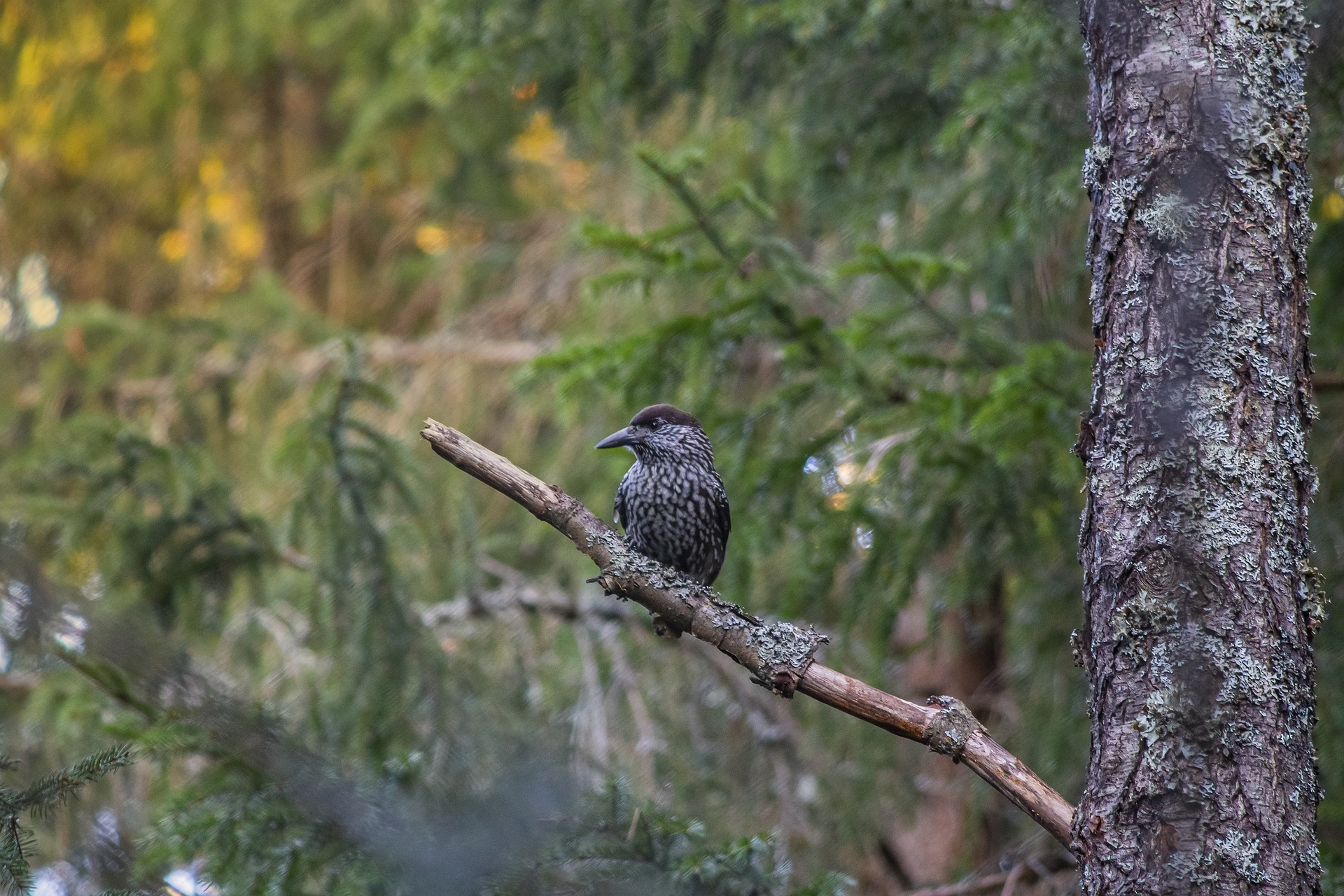The Spotted Nutcracker (Nucifraga caryocatactes) is a fascinating bird belonging to the crow family, Corvidae. Known for its distinctive spotted appearance and intelligent behavior, this species plays a crucial role in the dispersal of conifer seeds. Here’s an overview of the Spotted Nutcracker:
Appearance:
- Size: The Spotted Nutcracker is a medium-sized bird, measuring about 32 to 38 centimeters in length with a wingspan of approximately 53 to 58 centimeters.
- Coloration:
- Plumage: The overall plumage is dark brown to black with a dense pattern of white spots covering the head, neck, back, and underparts.
- Bill and Legs: The bill is strong, straight, and black, well-adapted for cracking open nuts and seeds. The legs are also black.
- Tail: The tail is relatively short and dark, often with a white-tipped tail feathers which can be visible in flight.
Habitat:
- Preferred Habitats: The Spotted Nutcracker inhabits coniferous and mixed forests, particularly favoring areas with an abundance of pine, spruce, and cedar trees.
- Geographic Range: This species is found across a broad range, including parts of Europe and Asia. It is particularly common in the mountainous regions of the Alps, Carpathians, and across Siberia.
Behavior:
- Feeding: The diet primarily consists of seeds, particularly those of pine and spruce. They also eat insects, small vertebrates, berries, and other plant materials.
- Caching: One of the most notable behaviors of the Spotted Nutcracker is its habit of caching seeds. It stores them in the ground or in crevices for later consumption, which helps in seed dispersal and forest regeneration.
- Foraging: They forage both on the ground and in trees, using their strong bills to extract seeds from cones.
Life Cycle:
- Breeding: The breeding season typically occurs from March to June. Spotted Nutcrackers build their nests in conifer trees, using twigs, moss, and other plant materials.
- Eggs: The female lays 2 to 4 eggs, which are incubated for about 18 days.
- Chicks: The chicks are altricial (born helpless) and are cared for by both parents. They fledge after about 23 to 26 days but continue to be fed by the parents for several more weeks.
Ecological Role:
- Seed Dispersal: By caching seeds, the Spotted Nutcracker plays a vital role in the dispersal and germination of conifer seeds, aiding in forest regeneration.
- Predation: It serves as both a predator and prey within its ecosystem, controlling insect populations and providing food for larger predators.
Conservation Status:
- Population: The Spotted Nutcracker is not currently considered threatened and has a stable population trend in most of its range.
- Threats: Habitat destruction and climate change can impact local populations, particularly in regions where coniferous forests are being reduced.
Interesting Facts:
- Memory: The Spotted Nutcracker has an excellent memory, allowing it to relocate its cached seeds even months later.
- Vocalizations: They have a varied vocal repertoire, including harsh calls and softer, more musical notes, often used to communicate with others in their territory.
- Subspecies: There are several recognized subspecies of Spotted Nutcracker, which vary slightly in size and plumage.
Identification Tips:
- Spotted Plumage: Look for the distinctive white spots on a dark brown to black background.
- Strong Bill: The sturdy, black bill is a key characteristic, well-suited for cracking seeds.
- Habitat: Observing them in coniferous forests, especially where pine and spruce trees are abundant, can aid in identification.
In summary, the Spotted Nutcracker (Nucifraga caryocatactes) is a remarkable bird with a unique appearance and important ecological role in seed dispersal. Its behaviors, particularly seed caching, contribute significantly to forest dynamics, making it a vital species in its native habitats.
Visited 107 times, 26 visit(s) today
Views: 157
Subscribe to the newsletter:
